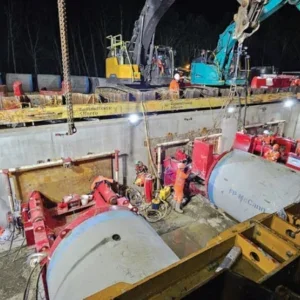The Airport Trail tunnel is an exciting project providing a unique transportation connection through northeast Calgary and to Calgary’s International Airport. The tunnel is 620m in length along Airport Trail and is located under the Calgary Airport Authority’s (CAA) new runway, taxiways and service roads.
The tunnel structure is being constructed to accommodate six lanes of traffic, with the provision for a future transitway.
The Airport Trail tunnel has been under consideration since the early 1990s. The landscape of the city has changed dramatically in that time, with the population increasing to more than 1 million people. The city has seen significant development taking place in many areas, including the northeast quadrant where the Airport is located.
The tunnel will help promote economic development by ensuring the efficient movement of workers and goods to and from the Airport, and will accommodate planned growth in the northeast and city-wide, both residential and industrial/commercial.
One of the purposes of the Airport Trail tunnel is to help connect people, goods and services locally, regionally and globally. The City is building the tunnel in conjunction with the CAA Runway Development Program, resulting in long-term cost saving.
Mayor Naheed Nenshi, who has been a champion for the construction of the tunnel, said "This tunnel is an important link for the future transportation network in Calgary and needed to be constructed now because of the timing of the airport runway construction."
In February 2011 Calgary’s City Council approved construction of the tunnel and five months later, excavation work began. A key component to the construction of the tunnel was the collaboration between City staff, consultants/ designers and contractors to develop the best design for construction requirements.
"We have worked closely with our consultant, CH2M Hill, along with our construction manager, a joint venture of PCL, Parsons and Dufferin, to deliver the work in a safe and efficient manner," said Duane Delaney, manager of major projects for The City’s Transportation Infrastructure business unit.
Tunnel excavation was approximately 15m deep by approximately 50m wide and involved the removal of more than 600,000 cubic meters of earth material and rock at the tunnel site.
This was not always an easy process because some of the subsurface rock was very difficult to break up and remove. For a significant portion of the excavation the contractor chose to use a terrain leveller to assist in the cutting and breaking up of the rock.
The project includes the installation of underground utilities. More than 2.5km of water and storm water utilities have been installed within the tunnel footprint.
Concrete work on the structure itself began with the installation of footings followed by forming and casting of the tunnel walls and roof.
Formwork (traveller forms) was mounted on rails to allow quicker set ups and concrete pours.
The walls and roof of the tunnel were poured in sections – 50 in total. For each section it took 80 trucks delivering a total of 850 cubic metres of concrete in a 12-hour period.
The first section was poured in February 2012 with the final section completed eight months later.
A total of 58,000 cubic metres of concrete was poured during the construction of the tunnel.
The tunnel is 36m wide with a concrete wall separating east and west-bound traffic, and the depth from the runway to the road surface is approximately 12m.
The project team found the coordination of hundreds of construction workers and the safe movement of large machinery a major challenge during the fast paced days of the construction pours.
Along with all the concrete work, 12,000t of reinforcing steel was installed, equivalent to about thirty 747 airplanes. Approximately 45km of electrical conduit has been installed.
This project resulted in the implementation of some innovative engineering and construction techniques:
Rolling tents for weather protection and curing
Liquid nitrogen cooling of the concrete during hot summer month weather
The use of granular material allowed backfill operations to continue throughout poor weather conditions
Engineered excavation slopes to reduce excavation and backfill quantities and schedule time
Reducing the size of cranes required to minimise disruption to the Calgary Airport.
One of the first important milestone dates was August 31, 2012, when The City handed over to the Airport Authority the area above the tunnel under the future runway. Less than a year later (July 2013), all areas above the tunnel had been handed over to the Authority.
Delaney said there were a number of challenges in keeping this project on-time and on-budget.
"Weather is always a factor when working on a large construction project outside," he said. "Add to that meeting tight timelines to avoid delay to the Airport Authority runway program and the coordination of hundreds of construction workers and numerous trade contractors.
"This is certainly one of the most interesting transportation projects in the city’s history."
The bulk of the current work is taking place inside the tunnel, mostly electrical and mechanical.
Thirty-two 100hp exhaust jet fans, weighing 2,000lbs (907kg) each, and 1,380 lighting fixtures have already been installed into the tunnel’s ceiling.
Various life safety systems including a linear fibre optic heat detector and smoke and gas detection, public address system, public emergency phone, fire extinguishers, fire doors, and dry stand pipe for the Calgary Fire Department hose connections are also currently being installed.
As of this winter road construction inside the tunnel and at the west and east approaches into the tunnel is substantially complete.
The project also included works involved in the widening of the Airport Trail east of the tunnel from four to six lanes.
In the future the tunnel will provide a significant link between the provincial ring road to the east and a major freeway, part of the north-south Alberta Highway 2, to the west.
In May of this year the Airport Trail tunnel is expected to open to traffic.






